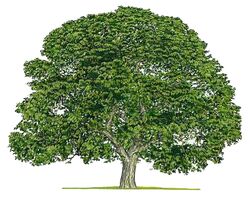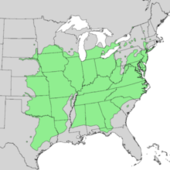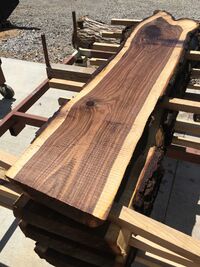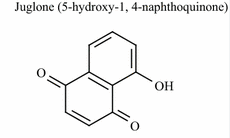Black Walnut

Description

Black walnuts are large, deciduous trees that have an average height of 75 to 100 feet [2], with a maximum height of 150 feet. [3] They typically mature within 150 years [4], growing an average of 13 to 24 inches per year, and producing fruit within 12 to 15 years. [5] The crown is oval or rounded and has a spread of 75 to 100 feet. [2] The leaves are feather-compound and alternate on the branches. Each leaf has anywhere from 15 to 23 leaflets that are finely-toothed, narrow, and slightly hairy underneath. The leaves are 1 foot to 2 feet long. When crushed, the leaves often have a spicy scent. Twigs are hairless and have white-woolish buds. The bark is dark, deeply grooved, and has dull ridges. Black walnuts have an average trunk diameter of two to four feet with a maximum diameter of six feet. [3] The blooms appear from May to June, are yellowish-green, and are insignificant. [2] The fruits appear from October to November [3], are showy, and have edible kernels. The fruits appear as large spherical nuts with yellow-green husks that turn black when the fruit falls. They are tolerant of rabbits and droughts. [2]
The genus name Juglans comes from the two Latin words jovis and glans meaning Jupiter and acorn, respectively. The name nigra means black, specifically referring to the dark bark and nuts. [2]
Habitat and Range

Black walnuts are native to North America and can most often be found growing in riparian zones. [1] They prefer moist, well-draining soil, that is organically rich and in full sun. These trees can not tolerate shade. [3] They can grow in acidic or alkaline soils as well as sandy, loamy, or clay soils. [5] Their range extends from southern Minnesota, Wisconsin, Michigan, Ontario, and New York, south to eastern Texas and northern Louisiana and Florida. It also extends from the east coast of Pennsylvania, Delaware, Maryland, Virginia, and North Carolina, west to eastern Nebraska, Kansas, Oklahoma, and Texas. [1]
Taxonomy
- Kingdom- Plantae (Plant)
- Phylum- Tracheophyta (Vascular Plants)
- Class- Dicotyledons (Flowering Plants)
- Order- Fagales (Flowering Plants)
- Family- Juglandaceae (Walnut Family)
- Genus- Juglans (Walnut Trees)
- Species- Juglans nigra (Black Walnut)
- Genus- Juglans (Walnut Trees)
- Family- Juglandaceae (Walnut Family)
- Order- Fagales (Flowering Plants)
- Class- Dicotyledons (Flowering Plants)
- Phylum- Tracheophyta (Vascular Plants)
Uses

Black walnut wood is very valuable given that the heartwood is strong, durable, heavy, and straight-grained. The wood is shock-resistant but can still be easily split, making it easily worked. It is ranked as one of the most durable heartwoods in the United States along with cedars, chestnuts, and black locusts. [1] This makes it a good choice for making veneers, cabinets, paddles, coffins, and gunstocks and for interior finishing. Different parts of the tree can also be used for coloring, with the bark being used for tanning and the husks from the fruit being used to make a yellow-green dye when extracts come from the outer part of the fruit and brownish-black dye when it comes from the inner part of the fruit. [3] These dyes can be used to stain cars, sidewalks, porches, and patios. The dark dye was also historically used by early settlers to dye hair. [1]
Several parts of the black walnut are also edible. The inner kernel of the fruit is eaten by rabbits and humans [3], with 65% of the annual harvest of black walnuts coming from the state of Missouri. [1] The twigs of the black walnut tree are also eaten by deer. [3] The sap of a black walnut can also be collected and drunk as is or concentrated into a syrup that is similar to the syrup of a sugar maple. [1]
Ecological Impact

Black walnuts produce a compound called juglone, an allelopathic chemical that can stunt the growth of other plants around the tree. The black walnut has the highest juglone potential out of any of the other walnuts. It was first recorded in 1881 as having a discouraging effect on the surrounding vegetation. The chemical restricts oxygen and food usage in both plants and animals, with a very small amount being required to sicken, sedate, or kill people and animals. It is typically produced by the tree in an attempt to protect its leaves, roots, and stems from grazing animals, insects, diseases, nematodes, and interfering plants. The highest concentrations of juglone precursors can be found in the buds, flowers, fruit, and phloem. [6] In order to kill the surrounding plants, the juglone leaches into the soil to infect the other plants. Here, the chemical can stay in the soil for up to two months, creating a long-lasting, negative effect on the surrounding ecosystem. [7] While several plants have the ability to tolerate the nearby presence of black walnuts and juglone, members of the tomato family, such as tomatos, potatoes, eggplants, and peppers, are highly sensitive and cannot survive near black walnut trees. Several shrubs (lilac, hydrangea, rhododendron, viburnum, and yew) are also sensitive to juglone. [8]
References
[1] Juglans nigra. 2023. Wikipedia. https://en.wikipedia.org/wiki/Juglans_nigra
[2] Juglans nigra. 2023. Missouri Botanical Garden. https://www.missouribotanicalgarden.org/PlantFinder/PlantFinderDetails.aspx?kempercode=a875
[3] Petrides, George A. Peterson Field Guides: Eastern Trees. Illustrated by Janet Wehr, New York City, Houghton Mifflin Harcourt, 1998.
[4] John Dickerson. Black Walnut: Juglans nigra L. 5 February 2022. USDA NRCS New York State Office. https://plants.usda.gov/DocumentLibrary/factsheet/pdf/fs_juni.pdf
[5] Black Walnut: Juglans nigra. 2023. Arbor Day Foundation. https://www.arborday.org/trees/treeguide/TreeDetail.cfm?ItemID=934
[6] Dr. Kim D. Coder. Black Walnut Allelopathy: Tree Chemical Warfare. January 2021. University of Georgia. https://bugwoodcloud.org/resource/files/18932.pdf
[7] Washtenaw County Conservation District. Black Walnut Toxicity. April 2001. Purdue University. https://www.washtenawcd.org/uploads/5/9/2/0/59207889/black_walnut_toxicity-website.pdf
[8] Cynthia Haynes. Juglone-What is It? 13 August 2021. Iowa State University. https://hortnews.extension.iastate.edu/2021/08/juglone-%E2%80%93-what-it